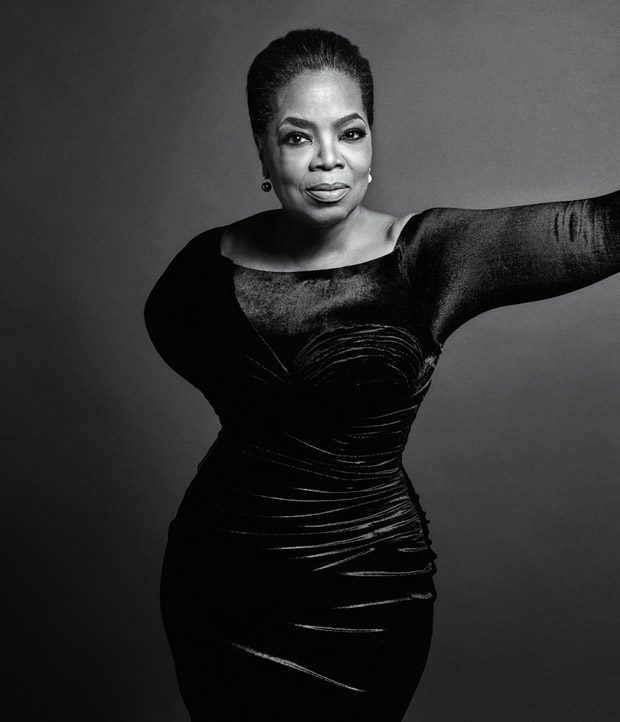
The one and only Oprah Winfrey stars in the cover story of WSJ. Magazine‘s March 2018 Women’s Fashion edition captured by fashion photographer Mario Sorrenti. In charge of styling was George Cortina, who for the session selected looks and accessories from Azzedine Alaia, Brandon Maxwell, Deborah Drattell, Belperron, David Webb, Sidney Garber, Mikimoto, Versace, Gucci, and Stephen Russell.
“No way, I do a few things really well. But I don’t want to manage. I don’t want to spend my days and nights creating policy. I want to continue to be involved with stories that allow people to see the best of themselves, to find a higher good.” – Oprah on a presidential run
For more images + story continue bellow:

Oprah on filming A Wrinkle In Time:
“I can’t remember the last time I had that much fun,” Winfrey says. “We were fired up. We were alive in that trailer every morning. Reese was the DJ, playing all this old Southern blues music. We listened to more Sam Cooke than I’ve heard since I was a kid.” Not only did she adore New Zealand (“It resonated with me…. There’s a heightened sense of color there that feels like another vibration,” she says), she had a blast with the cast. Witherspoon—who hails from Nashville, where Winfrey moved when she was 14 (“I think Southern girls have a thing,” Winfrey says)— first met her co-star when she was promoting the 2005 film Walk the Line on The Oprah Winfrey Show. “She completely Oprah-Showed me! I burst into tears talking about my high school English teacher,” Witherspoon says.
Reese Witherspoon on Oprah on set:
“We had at least four hours doing hair and makeup every day, and Oprah could have had her own trailer,” the actress says. “But she decided she wanted to do it with Mindy [Kaling] and myself. She really is like your best friend. She’s relatable, she loves to have a good time, she loves to drink a margarita.”
Ava DuVernay, Director of A Wrinkle In Time and Oprah friend:
“The thing about her being so powerful is that she doesn’t have to tolerate what does not nourish her,” “She has the power and the ability to practice ultimate discretion. Whatever she wants to do she does. Whatever she doesn’t want to do she does not.” She feels that acting is part of the Winfrey pantheon of talents that is most often overlooked. “When you think about her empire, you think of the show and all that,” DuVernay says, “but the acting would have been enough to have made her mark.”
Frank Luntz (Republican political consultant and pollster and 60 Minutes co-moderator) on Oprah:
“I don’t know anyone in America who can do what she does, and that is not an exaggeration,” he says. “I’ve been doing this for 25 years, and when I hosted a similar focus group two days before the election, I lost control. She has an innate, indescribable ability to find common ground among people who would otherwise kill each other.” After three tense hours around the table, the group’s discussion continued spontaneously in a nearby restaurant—with Winfrey herself choosing to join. “You know what that shows?” says Luntz. “Respect. That is what the average American is looking for from their leaders, from the media, you name it. I don’t think I share her politics, but it’s not about ideology. It’s about confidence in the future and respect towards each other. She provides both. I see her as the antidote for what ails this country.”

On her health during her Oprah Show reign:
“It wasn’t just a show for me. It really was me being part of the human exchange, the whole human array of functions and dysfunctions,” she says. “I’d go home, and I’d be overwhelmed. I was getting sick.” Winfrey had a different kind of health scare when a thyroid issue went undiagnosed. “I thought I was dying every night, because I had heart palpitations,” she says. “I went to five different doctors, and each of them gave me a prescription for a different kind of heart medication, and it turned out I didn’t have a heart problem at all.”
Oprah on her celebrity:
She insists on posing for every photo fans ask for and has little patience for celebrities who complain about the imposition. “If you don’t want to be a parade, then don’t go to the parade,” she says. “I try to be kind to people because people have been so kind to me, and I know it’s the only moment that they are going to have.”
Oprah on Politics:
“I want to see what the right side is saying and what the left side is saying,” she says, adding that what she doesn’t do much is watch the news. “I limit my intake,” she says. “All these commentators are on, and they’re just yakety-yaking. Everybody is talking to themselves. Nobody is listening to anybody. They’re there to make their point and make their moment, and we’re actually getting nowhere. So I turn it off.”
“Once you feel heard, you are willing to hear other people,” says Winfrey.
Oprah on her 60 Minutes specials:
“What I learned from all those conversations that I had for all those years is that everybody thinks they’re right, and it’s not my job to prove them right or wrong but to give them the opportunity to voice [their opinions], and we can have a constructive conversation,” she says. “Listen, I’ve looked in the eyes of murderers and child molesters and all kinds of people who have done terrible things. I can definitely listen to somebody who has a different political view.”
DuVernay on Oprah’s 60 Minutes specials:
“She knows the power of her voice, of her persona,” says DuVernay. “Does she need that paycheck? Does she need that little bit of PR? No. But she felt like someone needs to be talking to these people right now.”
On her choosing her Montecito estate:
Originally, she had looked at plantation houses in her native South. Having spent her early childhood poor in Kosciusko, Mississippi, she says, “I thought it would be the ultimate comeuppance, the ultimate finger. Like, ‘Look who’s in the big house now.’” But after an exhaustive search of antebellum real estate in Georgia, Alabama, Tennessee and Louisiana, she decided against it. “What you realize is that no matter how much money you have, you can’t get rid of the bugs and the humidity.”
WSJ. Magazine’s March 2018 issue is available on newsstands February 17, 2018 – www.wsj.com



















